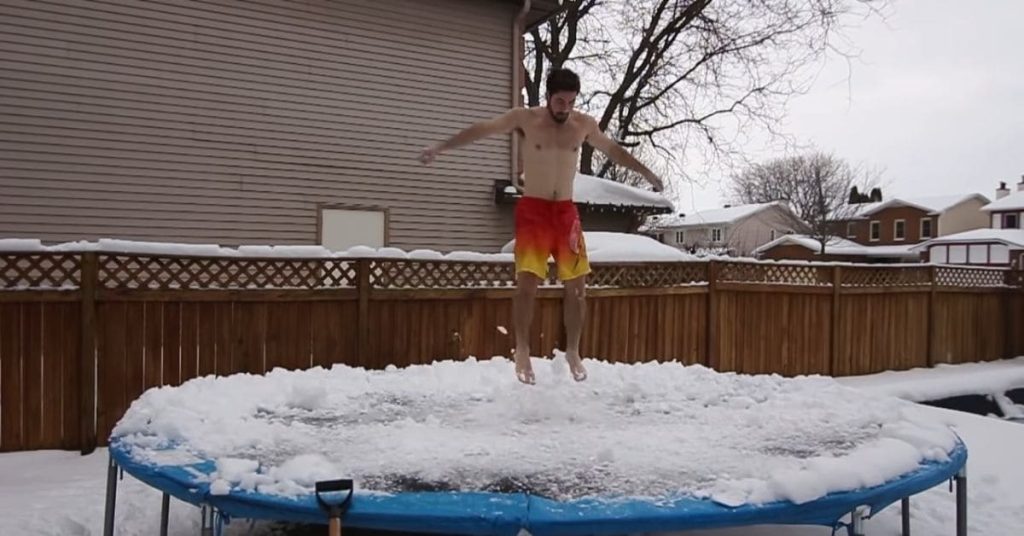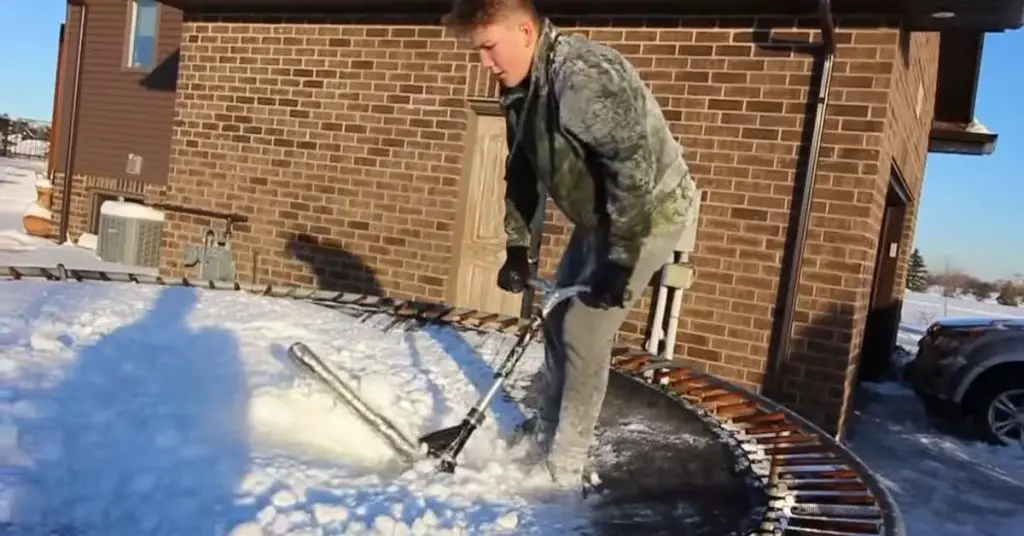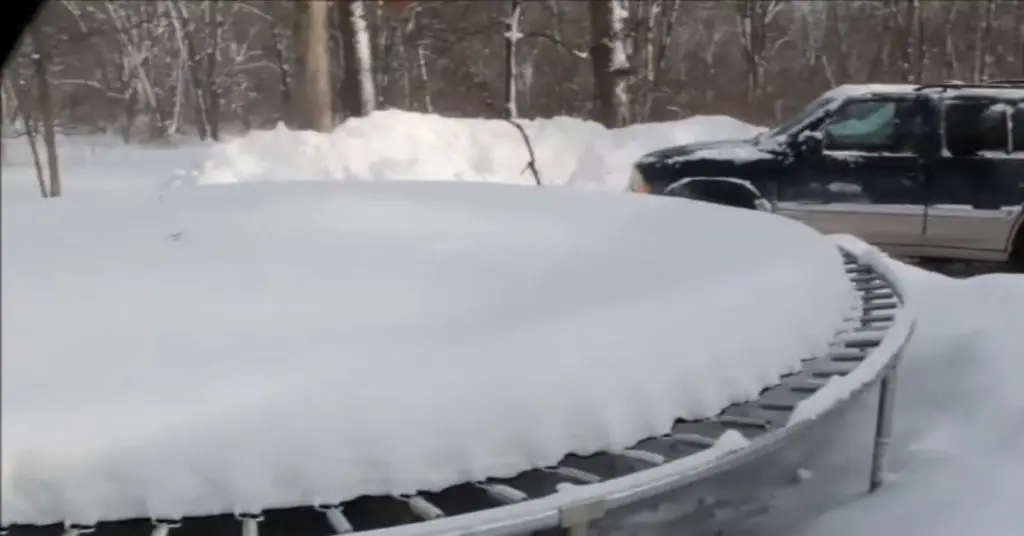Trampolines can provide hours of fun and entertainment for people of all ages, but as winter approaches, many trampoline owners are left wondering about the weight limit of their trampoline when it comes to snow. With heavy snowfall, it’s crucial to know how much weight your trampoline can hold to avoid damage or even injury.
The weight capacity of a trampoline depends on several factors, such as the size, weight limit, and the type of snow. Understanding the weight limit of your trampoline and the factors that affect it can help you take the necessary precautions to ensure your trampoline’s safety during the winter season.
From brushing off the snow to using trampoline storm covers, there are several ways to protect your trampoline during a snowstorm. In this article, we’ll explore in detail the weight capacity of trampolines, the factors that affect it, and how to safely enjoy your trampoline during the winter season.
How much snow can a trampoline hold: Knowing how much snow a trampoline can hold is crucial for its safety and maintenance. The weight capacity of a trampoline depends on several factors, and exceeding it can cause damage or injury. By understanding the weight limit and taking necessary precautions, you can safely enjoy your trampoline during the winter season.
How Much Snow Can a Trampoline Hold?

Trampolines are a great way to get exercise and have fun with family and friends, but when winter comes and snow begins to accumulate, many people wonder how much snow a trampoline can hold. It is important to know the weight limit of a trampoline and the factors that affect it in order to prevent damage to the trampoline and ensure safety while using it.
we will explore how much snow a trampoline can hold, factors that affect a trampoline’s weight limit, and examples of how much snow a trampoline can hold safely.
How Much Weight Trampolines Can Hold
The weight limit of a trampoline depends on the size and model of the trampoline. Most trampolines have a weight limit of 250-300 pounds, but some larger models can hold up to 400-450 pounds. It is important to check the manufacturer’s guidelines for the weight limit of your specific trampoline before using it.
When determining the weight limit of a trampoline, it is important to consider the weight of the users as well as any additional weight that may be placed on the trampoline, such as snow, toys, or other items. Exceeding the weight limit can cause damage to the trampoline and pose a safety risk.
Factors That Affect a Trampoline’s Weight Limit
Several factors can affect the weight limit of a trampoline, including the frame and spring quality, the age and condition of the trampoline, and the weather conditions.
The frame and spring quality of a trampoline are important factors in determining its weight limit. Higher-quality frames and springs are able to support more weight, while lower-quality materials may wear down over time and become less supportive.
It is important to regularly inspect and maintain the frame and springs of a trampoline to ensure their durability and safety.
The age and condition of a trampoline can also affect its weight limit. Older trampolines may have worn-down frames or springs that can no longer support as much weight as they once did. It is important to regularly inspect and maintain the trampoline to ensure its safety and durability.
Weather conditions, particularly heavy snow or rain, can also affect a trampoline’s weight limit. Wet or heavy snow can add significant weight to a trampoline and potentially exceed its weight limit. It is important to regularly remove snow and other debris from a trampoline to prevent damage and ensure safety.
Examples of How Much Snow a Trampoline Can Hold Safely
Related article: How Much Weight Can a 14-Foot Trampoline Hold
The amount of snow a trampoline can hold safely depends on several factors, including the size and weight limit of the trampoline, the quality of the frame and springs, and the weather conditions.
As a general rule, a trampoline can safely hold up to six inches of dry, powdery snow, but wet or heavy snow should be removed regularly to prevent damage and ensure safety.
It is important to regularly monitor the weight of the trampoline during periods of heavy snowfall and remove snow as necessary to prevent damage and ensure safety. When removing snow from a trampoline, it is important to use caution and avoid damaging the frame or springs. A soft-bristled broom or snow shovel can be used to gently remove snow from the surface of the trampoline.
Can You Jump on Your Trampoline During Winter?

Trampolines are a fun and exciting way to get exercise and enjoy the outdoors. But as winter approaches, many people wonder if it is safe to jump on a trampoline during the colder months.
we will discuss the pros and cons of jumping on a trampoline during winter, as well as the safety considerations to keep in mind when using a trampoline during this season.
Pros and Cons of Jumping on a Trampoline During Winter
One of the main benefits of jumping on a trampoline during winter is the opportunity to enjoy fresh air and outdoor exercise, even in colder weather. This can be especially important for individuals who may feel cooped up indoors during the winter months.
Jumping on a trampoline can also be a fun and exciting way to get exercise and improve coordination and balance.
However, there are also some potential drawbacks to jumping on a trampoline during winter. Colder temperatures can make the trampoline surface more slippery, increasing the risk of slips, falls, and injuries.
Additionally, snow and ice accumulation can add weight to the trampoline and potentially exceed its weight limit, leading to damage or collapse.
Safety Considerations to Keep in Mind When Using a Trampoline During Winter
Before jumping on a trampoline during winter, it is important to keep several safety considerations in mind.
Firstly, it is important to regularly inspect and maintain the trampoline to ensure its safety and durability. This includes checking the frame and springs for any signs of damage or wear, as well as ensuring that the weight limit is not exceeded.
Secondly, it is important to remove any snow or ice accumulation from the trampoline before using it. Wet or heavy snow can add significant weight to the trampoline and potentially cause damage or collapse. A soft-bristled broom or snow shovel can be used to gently remove snow from the surface of the trampoline.
Thirdly, it is important to dress appropriately for the weather when using a trampoline during winter. This includes wearing warm, layered clothing and non-slip shoes to prevent slips and falls on the trampoline surface.
Finally, it is important to use caution and follow proper jumping techniques when using a trampoline during winter. This includes avoiding high jumps and flips that could lead to injury, as well as avoiding jumping when the trampoline surface is wet or slippery.
In addition to these safety considerations, it is also important to use common sense and avoid jumping on a trampoline during winter when conditions are particularly hazardous. This includes periods of heavy snowfall, ice accumulation, or extremely low temperatures.
How to Clean Snow Off Your Trampoline?

If you own a trampoline and live in a snowy area, it is important to know how to safely remove snow from your trampoline to prevent damage and potential injuries.
we will provide step-by-step instructions on how to clean snow off your trampoline and the tools and equipment needed for the job.
How to Safely Remove Snow from a Trampoline
Step 1: Check the weight limit
Before removing snow from your trampoline, it is important to check the weight limit to ensure that the added weight of the snow does not exceed the limit. If the weight limit is exceeded, it is best to wait until some of the snow melts or manually remove some of the snow before jumping on the trampoline.
Step 2: Clear the area around the trampoline
Clear any obstacles and debris from around the trampoline to create a safe working area. This will help prevent slips and falls during the snow removal process.
Step 3: Use a broom to remove light snow
If the snow on the trampoline is light, a soft-bristled broom can be used to gently sweep the snow off the surface. Use sweeping motions from one side of the trampoline to the other, being careful not to apply too much pressure that could damage the trampoline or cause injury.
Step 4: Use a snow shovel for heavier snow

For heavier snow accumulation, a snow shovel can be used to remove the snow. It is important to use a plastic or rubber shovel to prevent damage to the trampoline. Begin by removing the snow from the edges of the trampoline and working your way toward the center. Avoid using a metal shovel, as it can scratch or dent the surface of the trampoline.
Step 5: Use warm water to melt ice
If there is ice on the trampoline, warm water can be used to melt it. Fill a bucket with warm water and pour it over the icy areas of the trampoline. Be careful not to use hot water, as it can cause the trampoline to warp or weaken.
Tools and Equipment Needed for Snow Removal
Soft-bristled broom: A soft-bristled broom can be used to gently sweep light snow off the trampoline surface.
Snow shovel: A plastic or rubber snow shovel can be used to remove heavier snow accumulation from the trampoline.
Warm water: Warm water can be used to melt ice on the trampoline surface.
Protective gloves: Wearing gloves can help protect your hands from the cold and prevent injury while removing snow from the trampoline.
Non-slip shoes: Wearing non-slip shoes can help prevent slips and falls on the trampoline surface during the snow removal process.
What Should You Do with A Trampoline in a Snowstorm?
Winter weather can be harsh and unforgiving, especially for outdoor equipment like trampolines. If you live in an area with frequent snowstorms, it is important to take steps to protect your trampoline and prevent damage.
we will provide tips on what you should do with a trampoline in a snowstorm and discuss the risks of leaving a trampoline exposed to harsh winter weather.
Tips on How to Protect a Trampoline During a Snowstorm
Use a trampoline cover: A trampoline cover can protect your trampoline from snow and ice buildup during a snowstorm. It is important to use a cover specifically designed for trampolines and to secure it properly to prevent it from blowing off in strong winds.
Remove the netting and padding: If your trampoline has netting or padding, it is recommended to remove them during a snowstorm to prevent them from becoming damaged. Store them in a dry, protected area until the storm has passed.
Secure the trampoline: Ensure that your trampoline is securely anchored to prevent it from being blown away during high winds. Use stakes or tie-downs to secure the frame and legs to the ground.
Brush off the snow: If your trampoline is exposed to snow during the storm, use a soft-bristled broom to gently remove the snow from the surface. This will prevent excess weight from building up and causing damage.
Risks of Leaving a Trampoline Exposed to Harsh Winter Weather
Damage to the frame and legs: If a trampoline is left exposed to harsh winter weather, the frame, and legs can become damaged. This is especially true if the trampoline is not securely anchored to the ground. High winds and heavy snow can cause the trampoline to shift or even tip over, resulting in damage or injury.
Damage to the mat and springs: Snow and ice buildup on the trampoline can cause damage to the mat and springs. Excess weight can cause the mat to stretch or tear, and the springs can become damaged or rusted.
Safety hazards: If a trampoline is not properly maintained and protected during a snowstorm, it can become a safety hazard. Excess weight from snow buildup or a tipped-over trampoline can cause injury to anyone nearby.
How to Maintain a Trampoline During Winter
Trampolines are a fun way to stay active and entertain yourself and your family. However, during the winter months, trampolines require extra attention to maintain their safety and durability. Winter weather can cause damage to the trampoline, which can lead to safety hazards and costly repairs.
we will discuss the importance of maintaining a trampoline during winter and provide tips on how to do so effectively.
The Importance of Maintaining a Trampoline During Winter
Safety: Maintaining a trampoline during winter is crucial to ensure safety. Winter weather can cause damage to the trampoline, which can lead to safety hazards and injuries. Maintaining a trampoline during winter ensures that it remains stable, secure, and safe to use.
Durability: Regular maintenance of a trampoline during winter ensures its durability. The trampoline’s mat, springs, and frame are all susceptible to damage during winter.
Regular maintenance can help prevent damage, prolong the life of the trampoline, and save money on costly repairs.
Tips on How to Maintain a Trampoline During Winter

Regular Maintenance: Regular maintenance is essential for keeping a trampoline in good condition during winter. It is recommended to inspect the trampoline for damage or wear regularly. Check the frame, legs, mat, springs, and safety pads for any signs of damage, and perform any necessary repairs promptly.
Dismantling the Trampoline: Dismantling the trampoline is an effective way to protect it from damage during winter. If possible, dismantle the trampoline and store it in a dry, protected area. This will protect it from snow and ice buildup, and prevent damage to the frame, springs, and mat.
Brushing off the Snow: If you are unable to dismantle the trampoline, it is important to brush off the snow regularly. Use a soft-bristled broom to gently remove the snow from the surface of the trampoline. This will prevent excess weight from building up and causing damage.
Using Trampoline Storm Covers: Trampoline storm covers are specifically designed to protect trampolines from harsh weather conditions, including snow, wind, and rain.
They are made from durable, waterproof materials that can withstand the elements. Using a trampoline storm cover can help protect your trampoline from damage during winter.
Jumping Tips On a Trampoline During Winter
Jumping on a trampoline can be a fun and enjoyable way to stay active, even during the winter months. However, it’s important to take extra precautions when jumping on a trampoline during winter to ensure your safety.
we will provide tips on how to jump safely on a trampoline during winter and discuss the risks of jumping on a trampoline during winter and how to mitigate them.
Tips on How to Jump Safely on a Trampoline During Winter
Dress Appropriately: Dressing appropriately is essential when jumping on a trampoline during winter. Wear warm, comfortable clothing, and make sure to cover your hands, feet, and head to prevent frostbite. Avoid wearing loose clothing or accessories that can get caught in the trampoline’s springs or frame.
Warm-Up: It’s essential to warm up before jumping on a trampoline, especially during winter. Stretch your muscles and joints to prevent injuries, and gradually increase your intensity and speed.
Take Breaks: Jumping on a trampoline can be a high-intensity exercise, so it’s essential to take breaks regularly. Rest and rehydrate to avoid fatigue and prevent injuries.
Jump in Pairs: Jumping in pairs can be a fun and safe way to enjoy the trampoline during winter. This can help prevent accidents and provide support for each other during jumps.
Risks of Jumping on a Trampoline During Winter and How to Mitigate Them
Slippery Surface: The trampoline’s surface can become slippery during winter, making it more difficult to maintain balance and control. To mitigate this risk, make sure to brush off any snow or ice from the surface of the trampoline before jumping.
Cold Temperatures: Cold temperatures can affect your body’s performance and increase the risk of injury. To mitigate this risk, make sure to dress appropriately and warm up properly before jumping.
Increased Risk of Injury: Jumping on a trampoline can be a high-risk activity, and this risk is increased during winter. To mitigate this risk, make sure to follow safety guidelines and take extra precautions when jumping on a trampoline during winter. Always jump with adult supervision and avoid performing dangerous or risky stunts.
FAQs
Q.1 Can I leave my trampoline out during the winter months?
It is generally not recommended to leave your trampoline out in the winter months, especially in areas with heavy snowfall. Snow and ice can damage the trampoline and its components, reducing its lifespan and safety.
Q.2 How can I protect my trampoline during a snowstorm?
To protect your trampoline during a snowstorm, it is best to dismantle it and store it indoors if possible. If this is not an option, you can cover it with a trampoline cover and remove any excess snow with a soft-bristled broom.
Q.3 What is the weight limit for my trampoline when it comes to snow?
The weight limit for a trampoline varies based on its size and construction, but most trampolines can safely hold between 200-500 pounds of evenly distributed weight, including snow.
Q.4 Is it safe to jump on a trampoline with snow on it?
Jumping on a trampoline with snow on it is not recommended as it can increase the risk of injury due to decreased traction and unpredictable bouncing.
Q.5 What are the best practices for cleaning snow off my trampoline?
To clean snow off your trampoline, use a soft-bristled broom to gently brush off the snow. Avoid using sharp tools or shovels that can damage the trampoline mat or frame.
Q.6 Are there any special maintenance requirements for trampolines during winter?
Regular maintenance is crucial for the longevity and safety of your trampoline, especially during winter. This includes inspecting the trampoline for damage, keeping it clean, and ensuring proper weight limits are not exceeded.
Q.7 Can I use a trampoline cover to protect it during the winter months?
Yes, using a trampoline cover can help protect it from snow, ice, and other harsh weather conditions. Make sure the cover is designed for your trampoline’s size and shape and that it is secured properly to prevent it from blowing away in high winds.
Conclusion
In conclusion, understanding how much snow a trampoline can hold and how to properly maintain it during winter is crucial to ensure its safety and longevity. The weight limit of a trampoline depends on various factors, such as its size, shape, and material.
It’s essential to know the weight limit and avoid exceeding it to prevent damage or accidents. Examples of how much snow a trampoline can safely hold can provide an idea of how to gauge the weight limit during winter.
Jumping on a trampoline during winter has its pros and cons, but safety should always come first. It’s important to consider safety considerations such as wearing appropriate clothing, checking for ice or slippery surfaces, and not jumping alone.
Additionally, knowing how to clean snow off the trampoline properly can prevent damage and accidents.
Using the five-step guide to safely remove snow from a trampoline can ensure that it’s clean and ready for use. It’s also important to protect the trampoline during a snowstorm by following specific tips and using appropriate equipment.
Leaving a trampoline exposed to harsh winter weather can result in damage, so maintaining it during winter is essential.
Lastly, jumping on a trampoline during winter can have risks, but proper mitigation measures can reduce accidents. Knowing how to jump safely and avoiding risky behaviors can prevent injuries.
Overall, with proper knowledge and precautions, a trampoline can provide fun and exercise throughout the winter season.
We hope this complete guide on How Much Snow Can a Trampoline Hold has helped you understand everything you need to know. If you have any questions or concerns, please don’t hesitate to leave a comment below!

